Research Feature > Seeing the city
*An Indian By Design Exclusive*
M/s Prabhakar B. Bhagwat founded LEAF (Landscape Environment Advancement Foundation) to engage in research and publication in the area of landscape design and environmental planning. It supports research programs of varying durations every year. The first of which is “Seeing the City” by Parin Shah, a student of Landscape Architecture.

Parin’s study on ‘Seeing the City’ is a subject close to my heart, that I believe requires plenty of discussion and action. There are increasingly no spaces one can spend time in that do not require one to spend money in. India’s idea of development is distorted – with no celebration or extension of the way our society grew, instead a blind embrace of the western – measured by shopping malls and hypermarts housing international brands and sales rather than the creation or continuence of chowk and maidaan like nourishing public spaces.
“Where do Amdavadis go out?” Parin attempted to answer this question. While doing so, she used the medium of water colours to capture the spirit of the city rather than just rely on a passive photograph. She observed locations, walked through streets studying the way people behaved and selected eight places. She then painted them in a manner where she laid more emphasis on some arrangements or aspects that she believed influenced the perception of the place. Presenting “Seeing the City”
Parin says: Spaces that allow solace, or contemplation and relief are critical in the city. Quoting Lawrence Halprin, “Work has become the dominant fact of human life, leisure and recreation a more or less luxurious afterthought which is fitted in around it. The dreary preponderance of building, the almost total absence of gardening, in our metropolis, is a direct reflection of this. Yet leisure and recreation, in their broadest sense, are fundamentally necessary factors of human life, especially in an industrial age.”
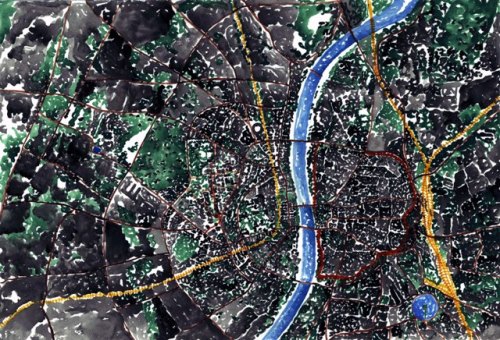
Ahmedabad was founded on the eastern bank of the river as a walled city. It is divided into two physically distinct eastern and western regions by the Sabarmati River, connected by bridges. The eastern part is established along the axis of Bhadra fort and Teen Darwaja. It is characterized by closed clusters of “pol” houses within the walled city. The western part is characterized by educational institutes, residential areas, malls, multiplexes and business districts such as Ashram road, CG road and Sarkhej-Gandhinagar highway. The city has grown by way of layers added on the existing settlement in concentric circles.
Teen Darwaja, Market Square, approx. 3150 square metres
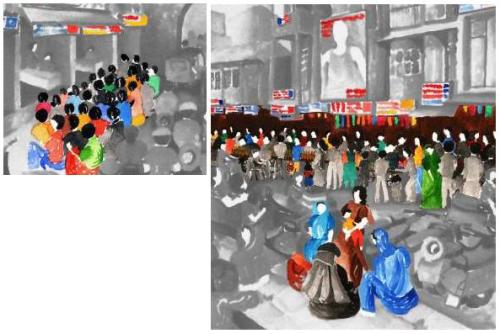

Parin says: “The existence of a class of people failing to make two square meals a day and waiting for free meals strikes a stark contrast to the hawkers who earn their living by selling goods on the road edges on a hot sunny summer day. Shoppers add motion to the life, quench their thirst at a road side facility and take a much needed break, seated on the divider.”
University Road – Street, approx. 1 kilometre long; 20 metres wide


Parin says: “To some this announces the beginning of a day with a cup of tea, to others it’s a place for refuge when bunking a lecture, to some it’s an occasion to celebrate after a cricket match, to some it marks the end of a tiring day, whereas to some others, it is just an excuse to meet friends and gossip, all this while looking at other people do the same.
Ashram Road – Streets, approx.3.7 kilometres long; 22 metres wide


Parin says: “A person seated on the bench looking at the city settling down after a long tiring day at work while going back to his house. Workers occupy the roadside footpath late in the evening, make temporary shelters and get together with their family after a long day.”
Ellis Bridge – Streets, approx. 270 metres long; 32 metres wide

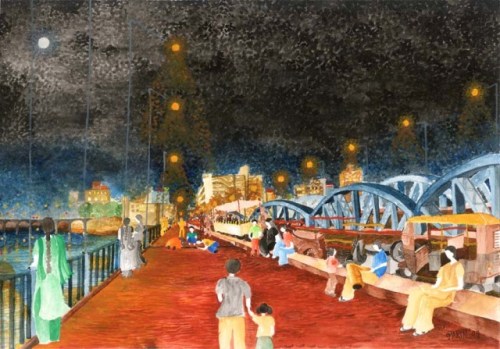
Parin says: “A rickshaw driver tired after a long busy hot day comes to the bridge and feels connected to the sky and the river below. He recounts the past few hours and contemplates about the next few before retiring for the day.”
Shopping Mall – Commercial place, approx. 750 square metres
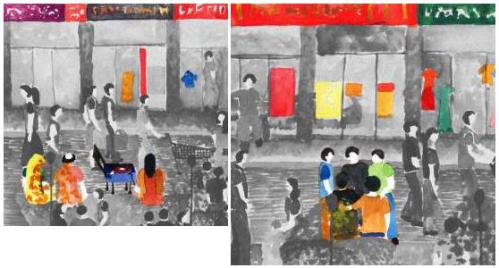
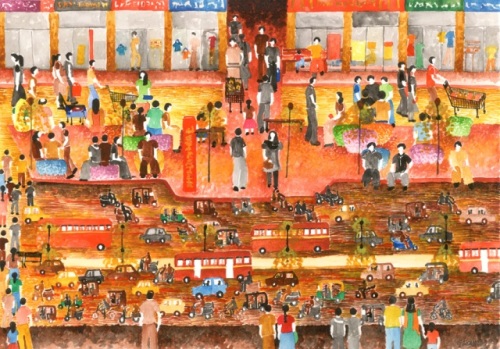
Parin says: “An elderly couple looks at the change in the way people spend time outside their homes while waiting for their son and daughter-in-law who have gone shopping inside the building. A group of friends from nearby area get together every evening for a quick chat before they head back to their own different tasks.”
Railway Station – Public building, approx. 1500 square metres


Parin says: “Sounds of people arguing and fighting near the reservation counters fill up the space. Even amidst complete chaos, people make themselves as comfortable as if at home. In the absence of effective policing it allows all kinds of people to occupy the floor, making it difficult to navigate even on foot.”
Ambawadi – Streets, approx. 2500 square metres

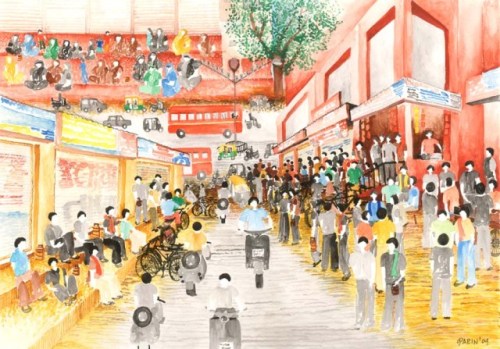
Parin says: “People come here all prepared with their lunch boxes and water bottles for the day ahead, adding another layer of commercial activity before the existing one starts. It is a place to mark the beginning of the day for friends.”
Atira – Institutional campus, approx. 2,72,000 square metres

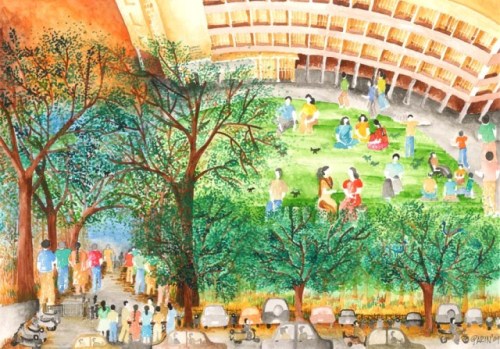
Parin says: “Old folk come in the evenings to chat for hours forgetting all the worries in the pleasant environment created by trees and chirping of birds. It attracts youngsters, children with parents and grandparents for morning and evening walks.”
Parin’s observations:
> Spaces like Teen Darwaja, University road, Ashram road, bridges, railway station, Ambawadi cross-roads, ATIRA are successful because they are policed to some extent. Spaces that are used well and occupied continuously are less likely to be vandalised, since the continuous presence of people acts as a form of social monitoring.
> It is important to look at non-labelled and un-programmed public spaces and formalise their occurrence in the planning of cities, since they are critical for the life and vitality in the city.
> Public spaces, which do not depend on some form of economic activity as its generator, survive well and are important to the city. Simple benches on the footpath allow people to sit while going back to the home in the evening. A person, who does not have money, finds a shelter on the footpath or in the railway station lounge. Abandoned grounds invite thousands of children in the weekend to play cricket. Many places in the city attract people without any activity generator such as eateries or shopping.
> The city needs accessible open spaces which can cater to all types of needs for its residents, regardless of gender, age, socio-economic background.
> There are very few places in the city where one can connect back to the nature. Green belts of the city have been destroyed by construction activities. It is essential to have such places in the city for the growth of individual.
> City needs common open public areas like maidans and squares where people of the city can come out at the time of the festivals, religious events, celebrations and share their happiness and sorrows.
> In conversation with Parin Shah
IndianByDesign: Why did you choose this as the topic for your research?
Parin: Globalization and urbanization has immensely affected our cities; it is assumed that in few years, more than half the world’s population will be residing in cities. 30% of India’s population lives in towns and cities as compared to 15% in 1947 when the country became independent as per census of 2001. With this rate of urbanization, cities also have responsibility of developing basic infrastructure which can create healthy living conditions for the community regardless of any age, gender and socio-economic background. In case of Ahmedabad, open space area per person is 0.37 sq.mt. as against a standard of 8-10 sq.mt. per person, specified by Urban Development guidelines of India. Same is the case with many cities of our country. Designated public open spaces such as gardens, parks and plazas are not enough for the recreational and leisure needs of the society. Very often these spaces are underutilized or do not allow people from various backgrounds and needs to use these spaces. As against this, non designed spaces allow congregation and draw people irrespective of economic background, age or gender. It is important to understand these various layers of spaces which are indispensable part of the city to generate a dialogue on re-evaluating the need of public open spaces, and hence this study.
IndianByDesign: What is public space? Where does it stem from?
Parin: Public space is an accessible open space, which can cater to all types of needs of the people, regardless of any distinctions. It could be a public park, play ground, traffic island, parking space, waste land, tea-stall on roadside, cross-road, road edge or even a foot path. These spaces reflect the spirit of the city, people come here at the end of a busy day or to meet friends or with their children, or after shopping or to begin a new day or just to sit and watch other people.
Public spaces originate from constantly changing and varying needs of people with age, gender, customs and habits; influenced by work and living conditions. Historically, there are examples of large maidans or open courts in front of the forts which acted as large public open spaces, used by the people at the time of celebrations, festivals and political events. Traditional market squares, bazaars, religious complexes also draw people from various backgrounds.
IndianByDesign: Where does the buck stop? Who is ultimately responsible for defining public spaces?
Parin: There is not one person or group responsible for defining public spaces. It’s a collaborative effort of designers, policy makers and people who are going to use this space. It is designers’ and policy makers’ responsibility to understand the diverse needs and incorporate these learnings in developing typologies which allow wide range of planned or spontaneous activities. They then can become integral part of our fabric.
IndianByDesign: What effect do you see this paucity have on the residents of the city or on the future of the city?
Parin: City needs spaces which allow relief and contemplation after a busy day at work, where one can connect back to the nature, where people can meet at the time of festivals, religious events, celebrations and share their happiness and sorrows. Public open spaces are biologically and ecologically essential for the development of the individual. The low quality or absence of these kinds of spaces affects living conditions, health and potential for economic development for large parts of the population.
IndianByDesign: You speak of the past and present of the space and how the past accommodated for communities and the present doesn’t. Could you elaborate?
Parin: The traditional closely clustered “pol” houses have spaces like “otla” and “chowk” where people of the community come out to meet other people. People gather here every evening to contemplate for the day, at the time of festivals to share their joys, at the time of communal riots or someone’s death to share their grief. Due to change in life style and urbanization, house forms are also changing. Societies and colonies still have common open plots, but very often these spaces are either used as parking spaces or they do not draw people due to various reasons. These reasons could be disallowance for multiple usages, lack of comfort etc. There were places like “maidans” and large “chowks” in the past where people of the city could get together at the time of religious events, political events or festivals. Traditional bazaar streets of the past still invite people from various economic backgrounds. These spaces are replaced by new typologies of shopping mall, multiplexes and plazas, which only invite certain class of people. Despite its apparent public and democratic nature, spaces have embedded in them the rights given to the class of people who are expected to use it.
IndianByDesign: You’ve raised pertinent points. And spoken of the issue at hand, but shared no possibilities or solutions. Why so?
Parin: Consciously, we did not want to come up with any solution, which can mislead the study. There is no definite solution to these spaces; it has a different answer for each city. The study does not pose anything, but puts a polite and honest portrayal of the public space of our cities. Based on these readers are free to make interrelations and conclusions.
The study intends to generate a dialogue on evaluating characteristics and the role that these spaces play in the city.
IndianByDesign: What after this research? How will it affect the work you do post this?
Parin: It is important to learn how to represent what we perceive; the study has sharpened the way I observe spaces. The method of representation helped in conveying these spaces in more contemplated manner as one observes many minute things while sketching or painting which is not often registered while photographing or making drawings. This method of understanding spaces and human behaviour; and then representing them has broadened my approach about the public spaces. It made me aware of various aspects to be considered from the point of view of the people who are going to use these spaces. If presented with an opportunity, these learnings will help me make an informed decision.
>> Material produced by LEAF may be freely reproduced. LEAF and the author should be acknowledged while doing so. The research document is available in the download section of their website – www.landscapeindia.net. LEAF invites applications for research positions. For details write to, M/S. Prabhakar B. Bhagwat, 901-Panchtirth, Opp. Aristoville, S.M.Road, Ahmedabad-380 015. INDIA # 91 79 2692 3054 or mail
Parin Shah is a student of the post graduate program in Landscape Architecture at CEPT University, Ahmedabad. This study is part of her summer training of 10 weeks. She graduated in architecture from the same university. Her passion for painting and sketching helped her to put these paintings together.
Filed under: Indian Architecture | 11 Comments
Tags: LEAF, M/s Prabhkar B Bhagwat, Parin Shah, Seeing the City



Sincerely liked the documentation..Being in Ahmedabad for more than a decade….the article makes me like the city more and more…The graphical presentation and its colours are really admirable..Other than Good Governance, Infrastructure, etc… Its the COLOURS that help us relate ourselves to the air around us….Good Post indeed…
You have presented the picture of Ahmedabad in a very thoughtful way … but more than that I loved the study of the nuances of a city life which needs very careful observation. Quite passionate !
I appreciate the idea of study. This is one part of study where you analyzed the characteristics and the role of different spaces in the city by comparing past and present conditions of cities; apart from that there are certain constraints which always leads to dynamic change of the cities.
Projected population (migration)
Industrial development (job opportunities)
And other economic factors.
These factors lead to the change of existing conditions of cities from A to B and B to C etc.
Results in reduced comfort area per person in the city. Which continuously change the behavior or activity pattern of the zones or areas of the cities by different individuals or continuous disorder (chaos) of activities. Designers and policy makers and an individual person can have control on the spaces for a certain time period only. Its characteristics changes again and again.
It is really a piece of extraordinary work; congratualtions
Parin you have put the story of Ahmedabad in a rare way of art; giving it both colours and words. It reflects that you see the city and its happening beyond surface.
Hope to see more of your work. Good luck.
Meticulous…………
Distinctively elaborated and clearly delineated.
Praiseful work.
Hope to see such work in future as well.
Excellant
I hail from Ahmedabad. I noticed that Mr. Parin has made very simple yet critical observations about the city. A graphical presentation drives home the point even more effectively. Great post indeed!
feels great
Excellant piece of work.
I really love your posts! They are different and very very informative,always so well put together,and I love that you feature people/ projects that are novel and new (to me).
Great stuff!:)
Sharon
I reallly like the documentation and the way it has been represented:)